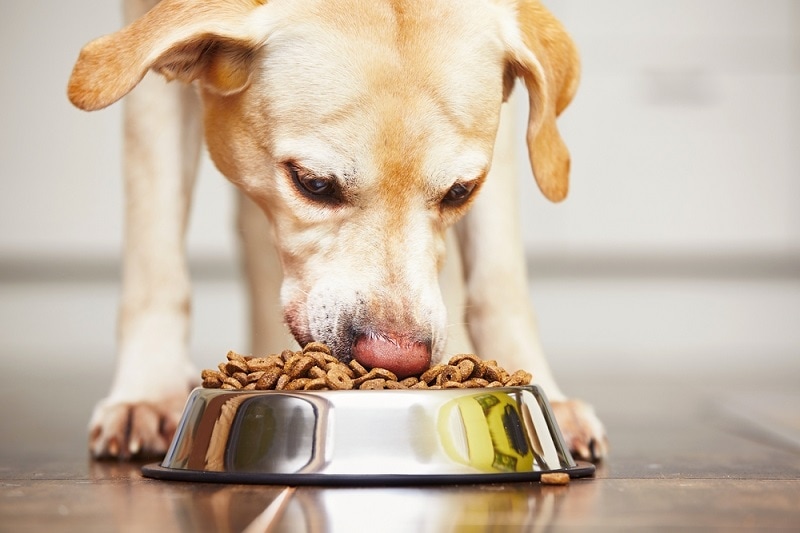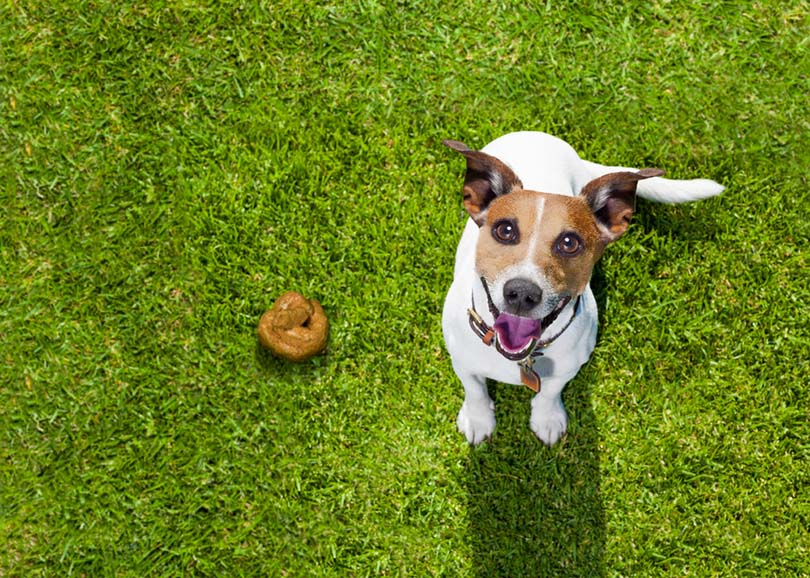For both dog owners and dogs alike, a healthy diet results in a healthy body in most cases. As dog parents, it is important to understand how your dog’s digestive tract works, as this can help you recognize when your dog needs medical attention.
A dog’s digestive tract consists of different areas throughout the body. It begins with the oral cavity—including the salivary glands, jaw, teeth, and tongue—followed by the esophagus, stomach, and the small and large intestines until it reaches the rectum and the anus. Other organs involved include the liver and the pancreas. Although the food does not directly pass through these organs, they play a vital role in breaking down the food during digestion as it passes along the tract.
Here are 10 fascinating facts about your dog’s gastrointestinal tract!
The 10 Facts About Your Dog’s Digestive System
1. Dogs have unique teeth
When your dog opens their mouth, you may notice that their teeth are sharper compared to your own human teeth. Dogs’ teeth are specifically designed to rip, tear, and shear tough meat—a trait inherited from their wild wolf counterparts. Your dog uses their canines and incisors in front of the mouth to rip and pull the food toward the back of the mouth. Their premolars and molars then grind up the food before they swallow it.
Dogs have a set of 42 teeth when fully grown—giving them more teeth than cats (who have 30), and humans (who have 32).

2. Dogs’ jaws only move up and down
Aside from the difference in shape and the total number of teeth, dogs also chew in a different manner compared to humans. While humans chew in a circular motion, with their jaw moving side to side, as well as up and down when grinding their food, dogs only chew up and down.
This has a lot to do with the shape of their teeth, as humans use the flat surface of their molars to grind their food, while dogs have sharper molars designed for shredding meat. Like their wild predatory cousins, their teeth and jaws are optimally designed for hunting, and their jaw movements are that of carnivores—perfect for tearing and swallowing meat.
3. Dog saliva has a different function
As pet owners, you’ve probably noticed your dog drool at least once. While dogs produce a lot of saliva, they serve a different function compared to that of humans. Human saliva contains enzymes that begin the breakdown of food as soon as the food enters the oral cavity. Dogs’ saliva, however, does not contain any sort of enzymes. Dogs salivate to simply lubricate the food in preparation for swallowing before going through the rest of their GI tract. However, recent research has shown that they can produce alpha-amylase in response to stress, this enzyme helps digest food.1
4. Dogs have a speedy intestinal tract
Dogs can pass food through their digestive tract much faster than humans. Humans typically take 20–30 hours for food to exit the tract, while dogs only take 6–8 hours. Dogs have a relatively shorter digestive tract compared to humans, and the quickness of passing food is another characteristic of a dominantly carnivorous lifestyle.

5. Dogs’ stomachs can store food
While dogs can pass food through their GI tract faster than humans, they are able to store food for a long period of time in their stomachs. This also allowed dogs to expand the size of their stomachs to make room for storage. Food is then slowly released to the intestines for digestion, depending on the dog’s need for energy.
Although no longer needed in their domesticated lifestyle, the ability to expand and store food in the stomach are products of evolution during their days in the wild. This allowed their predatory ancestors to survive longer durations in between meals.
6. Dogs have an extremely acidic stomach
Domesticated or in the wild, dogs tend to eat disgusting foods. You may have even caught your dog red-handed, eating something that they shouldn’t be. Dogs are actually scavengers by nature, dating back to their ancestors who had to scavenge for their food to survive—which is why you rarely see dogs get sick after consuming some questionable, “dirty” foods.
This is, in part, because dogs’ stomachs are extremely acidic, which kills many pathogens during digestion before they can even cause any harm. This also allows them to digest even the toughest of foods, such as bones and also aids in the quickness of their digestive tract.
Because of their acidic stomach, dogs can also suffer from indigestion, ulcers, and heartburn, just like humans. Should you suspect that your dog may be suffering from indigestion, consult with your veterinarian and they may recommend antacids to ease their discomfort.
7. Most dogs can digest carbs
Although dominantly carnivorous, modern dogs are considered omnivorous, which allows them to digest plant-based nutrients. Dogs have a smaller requirement for certain fatty acids and vitamins compared to true carnivores (such as cats), as dogs can create their own fatty acids from vegetable oils and plant-based foods. This aids most dogs in breaking down and absorbing carbohydrates during digestion.

8. Dogs need some fiber
Fibrous foods are often plant-based and are not fully broken down during digestion. Fiber is made up of two types, soluble and insoluble fiber. Insoluble fiber helps to sweep out the gastrointestinal tract, bulk up feces to promote defecation, and express the anal glands naturally, and soluble fiber provides a food source for healthy gut bacteria and is turned into short-chain fatty acids which are an energy source for gut cells.
A high-fiber diet may be recommended by the veterinarian should your dog experience issues with digestion, but it is generally not a requirement in dogs’ diets.
9. Cholesterol isn’t normally a concern for dogs
While humans must watch out for their fat intake and cholesterol levels, dogs’ digestive systems are designed to take in animal fat. While dogs do not experience the same problems as humans when it comes to fat intake, dog parents should still help them maintain a balanced diet to prevent obesity and other health problems. High cholesterol levels in dogs are usually indicative of other health problems rather than a high-cholesterol diet.
10. Dog stool is useful in determining their health status
One of the easiest and most common ways of detecting health complications in dogs is by observing their behavior—as well as their poop. Various infections from bacteria, parasites, and viruses can cause abnormal stool in your dog, which can be a sign that your dog may need to see a vet for medical attention.
Things to look out for regarding your dog’s poop can include the color, consistency, the presence of blood, and even the duration of your dog’s diarrhea. Vomiting is also a good sign of illness to be monitored, as well as constipation.
Seeking immediate medical attention after identifying an abnormal sign(s) in your dog can help prevent any further complications, and can even save your dog’s life.

Conclusion
As dog parents, it is our responsibility to give our fur babies the nutrition they need for a healthy lifestyle. Understanding our dog’s digestive system allows us to appropriately make decisions to ensure their optimal health and wellness. It is important to identify what is normal for our dog in order to also identify what is abnormal so that our dogs can live a happy and healthy life!
- See Also: Can Dogs Have Tums?
Featured Image Credit: chendongshan, Shutterstock
Contents
- The 10 Facts About Your Dog’s Digestive System
- 1. Dogs have unique teeth
- 2. Dogs’ jaws only move up and down
- 3. Dog saliva has a different function
- 4. Dogs have a speedy intestinal tract
- 5. Dogs’ stomachs can store food
- 6. Dogs have an extremely acidic stomach
- 7. Most dogs can digest carbs
- 8. Dogs need some fiber
- 9. Cholesterol isn’t normally a concern for dogs
- 10. Dog stool is useful in determining their health status
- Conclusion












